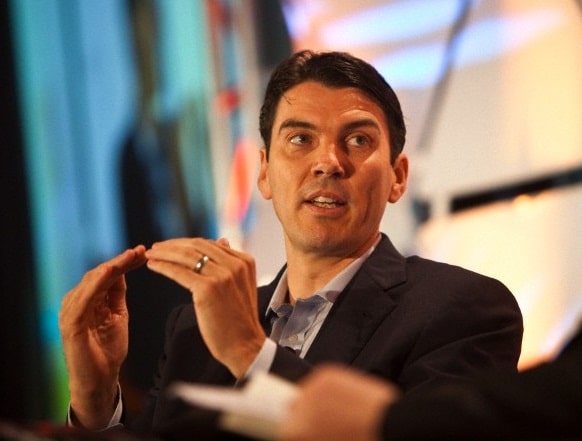
Many folks, including Netflix (NSDQ: NFLX) CEO Reed Hastings, suggest AOL (NYSE: AOL) should drop its declining ISP business. In fact, it already did that in Europe several years ago.
AOL’s operation there is a prototype for AOL’s life after access. So what does it look like… ?
AOL sold its ISP businesses in the UK, France and Germany for about €1.4 ($1.92/£1.22) billion in total, to Carphone Warehouse (2006), Neuf Cegetel (2008) and Telecom Italia (2008) respectively.
There, AOL Europe has been operating solely a content business for a couple of years now. Unfortunately, AOL’s international revenue has also been in decline ever since…
Highcharts.setOptions( {"lang":{"numericSymbols":["K","M","B","T"]}} );
(function( $ ) { $(function() { var options_723551 = go_datamodule_723551;
options_723551.series = [{name: 'AOL international revenue', connectNulls: true, data: [31.6, 22.2, 20, 18.1, 24.7, 15.8, 12, 8.3, 11.5, 8.5, 10.8]}]; options_723551.tooltip = { formatter: function() { var series_name = ''; var x_name = this.x;
if ( this.series.name != options_723551.title.text ) { series_name = this.series.name + ': '; }// END if
if ( go_datamodule_723551.hasOwnProperty( 'original_labels' ) ) { x_name = go_datamodule_723551.original_labels[ this.point.x ]; }// END if
return series_name + x_name + ': ' + go_datamodule.add_commas(this.y) + ''; } };
options_723551.plotOptions.formatter = function() { return '' + go_datamodule.add_commas(this.y) + ''; };
options_723551.xAxis.categories = ["08 Q4","09 Q1","09 Q2","09 Q3","09 Q4","10 Q1","10 Q2","10 Q3","10 Q4","11 Q1","11 Q2"];
options_723551.chart.events = {}; options_723551.chart.events.load = function( e, chart ) { $(this.legend.allItems).each( function() { var current_height = this.legendSymbol.height; var desired_height = options_723551.legend.symbolHeight;
var diff = desired_height - current_height; var current_y = this.legendSymbol.y;
this.legendSymbol.attr( 'height', options_723551.legend.symbolHeight ); this.legendSymbol.attr( 'y', current_y - diff ); }); };
options_723551 = Highcharts.merge( highcharts_theme, options_723551 );
$( '#highcharts-data-wp-chart-t-render-723551' ).highcharts( options_723551, function( chart ) { } );
highcharts_data_wp_chart_723551 = $( '#highcharts-data-wp-chart-t-render-723551' ).highcharts();
}); })(jQuery);
Coincidence? *Time* and again, in disclosures over the three years since, AOL has blamed the decline on fewer subsequent search queries and less contextual ad revenue coming from the countries it sold off. After all, when the number of ISP subscribers seeing an AOL homepage drops, so does the number of people seeing AOL homepage ads and search ads.
Despite embracing non-ISP businesses, a review AOL carried out after the sell-offs concluded: “Many international markets are unprofitable and lack the appropriate infrastructure for success. In 2010, we will exit the vast majority of those markets.” The performance and sell-off of Bebo, ICQ and Buy.at also dragged results down.
The pattern continues. Even in the last quarter, Q2 2011, AOL took a “$4.3 (£2.74) million impact from fewer international queries“. Exiting the European ISP market has also allowed AOL to reduce its costs, however.
AOL’s income from access subscriptions may be in decline (-21 percent in the last year), but this income still represents more than a third of its total. and was only surpassed by advertising relatively recently. Abandoning that before the content business is fully built out (especially in its recent state of turmoil) would be like cutting off a leg.
In fact, advertising and ISP are actually mutually interdependent. Early in 2010, AOL reported lower search and advertising revenue thanks to a 27 percent annual ISP subscriber drop-off, because “AOL subscribers tend to search more frequently and typically monetize at a higher rate than non-paying visitors“.
Consider a successful business like BSkyB (NYSE: BSY), which is both an access provider (ISP, satellite TV, telephony) and a maker of content for each. Many such businesses consider this the ultimate sweet spot, promising up-sell of one service to users of the other, and ongoing bundled bliss. But that kind of relationship between AOL’s content and its dial-up wings, at some point, will likely be but a memory.
AOL, then, may think hard before switching off its original business until its new one truly blossoms.